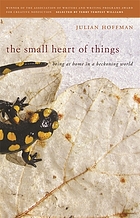 What a quiet, lovely book is The Small Heart of Things: Being at Home in a Beckoning World by Julian Hoffman. In 2000, Hoffman and his partner, Julia, moved to the Prespa Lakes region in northern Greece. The main lake, Lake Prespa is situated in such a way that the borders of Greece, Albania and the Republic of Macedonia all meet somewhere in the middle of it. The area has seen more than its share of conflict from Albanians feeling communist rule to the Greek Civil War to the break up of Yugoslavia and Macedonia becoming its own country. Hoffman discusses pieces of this history in the context of what it has done to the people who live there , their traditional ways, and the unique ecology of the place.
What a quiet, lovely book is The Small Heart of Things: Being at Home in a Beckoning World by Julian Hoffman. In 2000, Hoffman and his partner, Julia, moved to the Prespa Lakes region in northern Greece. The main lake, Lake Prespa is situated in such a way that the borders of Greece, Albania and the Republic of Macedonia all meet somewhere in the middle of it. The area has seen more than its share of conflict from Albanians feeling communist rule to the Greek Civil War to the break up of Yugoslavia and Macedonia becoming its own country. Hoffman discusses pieces of this history in the context of what it has done to the people who live there , their traditional ways, and the unique ecology of the place.
When Hoffman and Julia first moved to the area they made part of their living as market gardeners. Now, the pair monitor bird populations in the upland areas where wind farms are being built. As a bird expert, the book is filled with bird observations as you might expect. But it is also filled with observations of geology and how people live in and with the nature. It is a book that is deeply imbued with a sense of place and what it means to belong to that place.
More a series of essays than a start to finish memoir, each piece focuses on something different. “Homing” is about our need for finding a place we can belong and call home. “Among Reeds” is about walking through a reed bed and discovering bitterns live there. While “Time in Karst Country” is about karst, how it was created, how deceptive and seemingly barren it is. But it is more than that,
There is a distinctiveness brought about by weathering and ageing, both limestone and ourselves the inconstant ones, enduring the elements, overcoming the flaws of our inheritance. Dissolution is more than a lessening; it’s a reminder of time worn well.
Another essay, “The Distance Between Us” is a wonderful story about when Hoffman was walking on the hills above Morecambe Bay in Cumbria and noticed a man walking far ahead of him. He gradually began to catch up and then the path went down into a small, narrow valley, the man disappeared over the edge of it and a few minutes later when Hoffman arrived the man was nowhere to be seen. He was worried there had been an accident and searched around but the man was gone. This happened years and years ago but he still thinks about the man especially when he is out walking and spies a solitary person walking ahead of him. The essay then turns into a meditation on the impact strangers can have on our lives without even knowing it. And, conversely, the impact we also must make on other people’s lives that we are unaware of.
One of my favorite essays is the titular essay, “The Small Heart of Things.” It is about the successful reintroduction of the beaver to Transylvania. The animal had been absent from the country for two hundred years, trapped and hunted to extinction for their fur. The beaver was so important to the country at one time there are cities and villages, common words and surnames based on the word for beaver. The reintroduction has been a smashing success. The beavers are thriving and spreading out among the country’s waterways. And, even though there is a fund to which farmers and others can apply to be reimbursed for damage a beaver may do, hardly anyone has used it, not because there has not been damage, but because people are so happy to have the beavers back in their lives again that they accept the damage as part of the relationship.
Hoffman asks,
Extinction and preservation ask of us essentially the same thing: what is the meaning and measure of loss?
And he goes on to observe:
While we may adapt to the absence of things, either easily or over time, each extinction diminishes our lives as well; each fragment as essential as the next when attempting to understand our place on the planet. Loss lessens our shared inheritance, and the world is made inescapably smaller.
The Small Heart of Things is a slim book but it is packed with such clear-eyed observations and thoughtful meditations that it feels much bigger than it is. It is a book about being part of a place, being part of something bigger than you. It tells us how to do this too, by slow, careful attention, by being present in the world and by forming relationships to the things of the world both common and rare. Hoffman reveals time and again, it is those relationships that matter most.
Filed under: Books, Essays, Nonfiction, Reviews Tagged: nature, Prespa Lakes


